Biology:Bigmouth buffalo
| Bigmouth buffalo | |
|---|---|
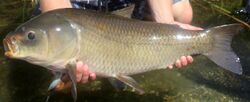
| |
| Bigmouth buffalo male | |
| Scientific classification | |
| Kingdom: | Animalia |
| Phylum: | Chordata |
| Class: | Actinopterygii |
| Order: | Cypriniformes |
| Family: | Catostomidae |
| Genus: | Ictiobus |
| Species: | I. cyprinellus
|
| Binomial name | |
| Ictiobus cyprinellus (Valenciennes, 1844)
| |
| Synonyms | |
| |
The bigmouth buffalo (Ictiobus cyprinellus) is a fish native to North America that is in decline.[2][3][4][5] It is the largest North American species in the Catostomidae or "sucker" family, and is one of the longest-lived and latest-maturing freshwater fishes, capable of living 127 years and reproducing infrequently.[4][5][3] Even at a century old they show no age-related declines, but instead improvements relative to younger individuals, making this species a biological marvel.[6] It is commonly called the gourdhead, marblehead, redmouth buffalo, buffalofish, bernard buffalo, roundhead, or brown buffalo.[7] The bigmouth buffalo is not a carp, nor is any other fish in the sucker family. Although they share the same order, each belong to different suborders and are native to separate continents.
The bigmouth buffalo is typically a brownish olive color with dusky fins, but can vary greatly in color across individuals including melanistic, golden, and even xanthic color morphs.[8] Like other catostomids it has a long dorsal fin, but unlike all other extant species it has a terminal (forward-facing) mouth reflecting its unique, pelagic feeding ecology. It is the largest of the buffalofishes and can reach a length of more than 4 ft (1.2 m) and 80 lb (36 kg) in weight. Generally it lives in lakes, or in sluggish areas of large rivers. Bigmouth buffalo populations have been in decline in the northern extent of their range since the 1970s, including Minnesota, North Dakota, and Canada.[2]
A 2019 study documented their late maturity, centenarian longevity, and that several populations in northwestern Minnesota are composed mainly (85–90%) of individuals more than 80 years old, indicating recruitment failure since the 1930s.[3] A 2021 study from North Dakota also revealed a slow pace of life including late maturity, decadal episodic recruitment, and a relatively large group of old-growth individuals.[4] A 2022 study from Saskatchewan, Canada revealed remarkable tendencies of the bigmouth buffalo including a supercentenarian lifespan, skip-spawning related to water levels, proximate mechanisms underlying failed recruitment, extreme episodic recruitment, and late maturity[5]—all characteristics that make this species extremely vulnerable to overfishing, habitat degradation, and invasive species. Indeed, bigmouth buffalo are declining in Canada,[5] and have been in steep decline in contiguous areas of the US, temporally associated with the rise of modern bowfishing in the 21st century.[4][9] Their life history attributes, including the ability to survive several decades with no successful recruitment (i.e. episodic recruitment), are more pronounced than other long-lived freshwater fishes, including sturgeon and paddlefish.[4][3] Such long-lived species require time to successfully sustain themselves by surviving to periods in which favorable environmental conditions arise for booms in reproduction and subsequent recruitment.[10] Unregulated and unmanaged lethal fisheries are not compatible with their biology, yet such fisheries exist in the United States and the species is declining.[4] Canada on the other hand, has long-enforced protections for the species.[5]
Geographic distribution
The bigmouth buffalo's native distribution is confined to the countries of Canada and the United States of America.[11] It is native to the Red River of the North and Mississippi River drainage basins, from Manitoba, Canada, and North Dakota, United States, to the Ohio River and south in the Mississippi River system to Texas and Alabama. In Canada, they inhabit the Milk River which flows through Alberta, and the Qu'Appelle River which flows through Saskatchewan and Manitoba into Lake Winnipeg. Beginning in the northern United States, they are native to Montana, North Dakota, Minnesota, Wisconsin, and down to southern states including eastern Texas, Oklahoma and Louisiana. The major systems where they are found include the Hudson Bay and Mississippi River drainages. The introduction of bigmouth buffalo has largely been done for commercial purposes. Regions of reintroductions include some reservoirs along the Missouri River drainage of North Dakota and Montana. Regions of introduction include some reservoirs in Arizona, and within California , they have also been introduced to the aqueduct system of Los Angeles .[12]
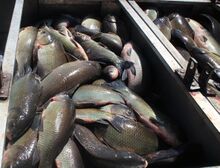
File:A female bigmouth buffalo.ogv
Ecological, cultural, and economic importance
Native to North America, bigmouth buffalo are integral to ecosystems therein. Bigmouth buffalo young are prey for several predatory fish, including walleye,[16] northern pike,[17] catfish,[18][19] alligator gar,[20][21] etc. Bigmouth buffalo filter-feed on invasive zebra mussels during the mollusk's larval (veliger) planktonic stage.[22][23] They form the native counterpart to the invasive bighead and silver carp, and they compete with the invasive common carp.[5] However, these invasive species are outcompeting native bigmouth buffalo.[5][3][19][23] Native Americans utilized bigmouth buffalo, Lewis and Clark harvested them on their journey in 1804, and the inland commercial fishing industry has valued them as a prized catch since the 1800s.[3] The bigmouth buffalo is a popular foodfish throughout the United States, and has been introduced into a few southwestern states. Commercial harvesters have to obtain annual permits to net from designated waterbodies, which are rotated among on a year-by-year basis, and they must report harvest from each haul to their respective state agency. Bigmouth buffalo are then trucked in oxygenated water tanks to markets where they are sold alive.[13] They are commonly consumed in Arkansas as buffalo ribs.[24] Though it has small bones suspended in its muscle tissue like northern pike, its good flavor makes it one of the most valuable of the traditional, non-game freshwater fish. In addition to being a foodfish, the bigmouth buffalo has recently become a sportfish, as night and day bowfishing have become increasingly popular in the 21st century.[4][3][9][25] Although commercial harvest is regulated, sport bowfishing is not.[4][3][9][25]
Ecology
File:Bigmouth buffalo young feeding on zooplankton.ogv
The bigmouth buffalo is part of a unique ecology in shallow-water systems. The larval bigmouths are pelagic and sometimes benthic feeders, mostly of copepods and cladocerans, but also phytoplankton and chironomids.[11][26] Bigmouth buffalo, unlike its close relatives the black and smallmouth buffalos, is a filter-feeder, using its very fine gill rakers to strain plankton from the water. It sometimes feeds near the bottom, using short up-and down movements to filter from the water the plankton that hover near the bottom or rest lightly on it.[27] The juveniles and adults are mostly limnetic plankton feeders that also eat cladocerans, copepods, algae, chironomids, ostracods, and other insect larvae and invertebrates depending on availability.[28][29] The optimum habitat for spawning bigmouth buffalo is highly vegetated waters. They are a very resilient fish that can tolerate high turbidity and low oxygen levels. They can be found in waters with turbidity levels over 100 ppm. A minimum total dissolved solids is 200 ppm during the growing season. During spring and summer, 50–75% pools should be present, with backwaters, and marsh areas and 25-75% littoral area and protected embayments during summer for the habitat to be suitable.[12] Bigmouth can be found in waters from 22.5 to 38.0 °C (72.5 to 100.4 °F). The optimal temperatures for incubation and hatching of eggs are from 15–18 °C (59–64 °F), but they can develop in temperatures reaching up to 26.7 °C (80.1 °F).[12] The bigmouth buffalo prefers slow-moving water that does not reach a velocity over 30 cm/s.
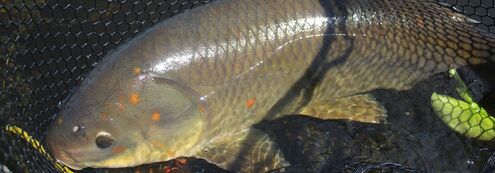
The bigmouth buffalo are group spawners[5] which produce 250,000 eggs/kg of adult weight; their eggs are about 1.5 mm in diameter.[31][11] The bigmouth buffalo is a spring spawner generally spawning between April and June when the water temperature is between 13 and 26 °C (55 and 79 °F), but may skip spawning if water-level fluctuations are not adequate.[3][5] The bigmouth buffalo is a broadcaster that has adhesive eggs, which it lays in vegetated waters. Females seek submergent and emergent vegetation, the ideal habitat for the hatching of their eggs. Water levels substantially rise before spawning.[4][5]
Salinity can be a problem for reproduction. Spawning can occur from 1.4 to 2.0 ppt of salinity which eggs and yearlings not being able to survive a salinity of over 9 ppt.[32] The minimum dissolved oxygen during the spring and summer is 5 mg/L.[12]
Recruitment success is related to water-level and drought conditions,[4] as well as the water-level recession rate after the spring peak.[5] More than one male will assist in spawning by moving the female to the top of the water to help mix eggs and milt.[5][33]
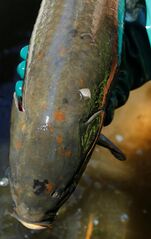
Life history
Reaching a recorded maximum of 127 years of age, the bigmouth buffalo is currently the longest living freshwater teleost (a group of more than 12,000 species) by more than 50 years, shattering all previous records for this group.[5][3][14][34] With a previous maximum longevity estimate (prior to 2019) for this species at 26 years,[35] evidence of its extended longevity came as a surprise and was initially met with skepticism.[36] Thorough bomb radiocarbon dating was conducted on their otolith microstructure and confirmed the age estimates generated from thin-sectioned otoliths, making bigmouth buffalo the oldest age-validated freshwater fish in the world.[3][15]
The onset of sexual maturity of bigmouth buffalo varies with latitude. In central North Dakota and southern Minnesota, females reach the onset of sexual maturation around 10 years old, while males begin maturation around 6 years of age.[4][3] In Canada, bigmouth buffalo females had not yet reached the onset of sexual maturity by an age of 11 years.[5] Their delayed maturity (in addition to their great longevity and episodic recruitment) is a trait indicative of their slow, marathon-like, life history pace. Bigmouth buffalo have a tendency to accumulate unique pigmentation (orange and black spots) as they age,[3][15] but this may vary by habitat depending on water quality and food intake.
Conservation status
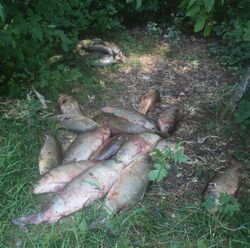
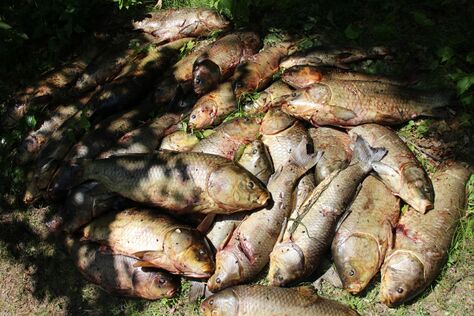
According to the Committee on the Status of Endangered Wildlife in Canada, the conservation status in the Canadian range of the bigmouth buffalo is difficult to assess due to lack of study of this animal, and the species is of special concern under the Species at Risk Act.[37][5] Known threats include loss of backwater spawning areas due to channelization and loss of spawn viability due to high turbidity related to variation in flow rate.[37] The bigmouth buffalo is also negatively affected by dams that restrict their movement and ability to find suitable spawning habitat, they are prone to winterkill, and they are highly vulnerable to overfishing.[4][5][3][9][25] The bigmouth buffalo is an endangered fish species in Pennsylvania.[38] Besides this state, the bigmouth buffalo is not currently listed as threatened or endangered in any other region of its native distribution, although the Saskatchewan - Nelson River populations designatable unit has been listed under Schedule 1 of the Species at Risk Act as being of special concern since 2011 due to contiguous declines[5][3][37] that have also been evident in the northern extent of their US range since the 1970s.[2] Surprisingly, several longstanding MN populations are composed almost totally (85–90%) of individuals hatched before 1940, while harvest limits do not exist in these same areas - this despite the rapidly growing new sport of modernized night bowfishing that exploits this species.[4][9][25] Indeed, the rise of bowfishing was found to be coincident with steep declines in bigmouth buffalo.[4]
The fingerlings of bigmouth buffalo are susceptible to a parasite, Lernea cyprinacae, but most are unaffected by the time they reach a length of 30 mm.[31] They are anchor parasites that attach themselves between scale margins and fin insertions. The real problem is a secondary infection that may arise due to these parasites, especially in poor water conditions. The protozoan Epistylis and bacteria Flavobacterium columnare are both related to serious parasite infestations.[31] The bigmouth has been seen to hybridize in the wild with smallmouth buffalo, and it is possible that some fish identified as black buffalo are indeed these hybrids.[39] The hybridization does not seem to be negatively affecting their populations but makes it difficult to determine how many hybrids and how many black buffalo are actually in certain reservoirs. The fish is vulnerable in shallow water and is often captured by bow and arrow via bowfishing.[9][25] It is commercially caught on trotlines, setlines, hoop and trammel nets, and seines. There are currently no specific management plans in place for the bigmouth buffalo in the United States.[4][3][9][25][40] In some places like the southern US, progeny have been reared in hatcheries.[31]
Management of bigmouth buffalo is in need of attention, especially in the northern part of their US range where populations are old-growth and declining.[4][2] Overall, the International Union for Conservation of Nature did not consider bigmouth buffalo to be at risk of extinction in its 2013 assessment,[1] which came before recent developments in the understanding of the life history of Ictobius cyprinellus.[34]
Fishing
On June 21, 2013, Noah LaBarge (12 years old)[41] caught the Wisconsin state record bigmouth buffalo fish.[42] It measured 49.5 inches (126 cm) and weighed 76.5 pounds (34.7 kg).[42] It was caught on 8-lb-test line[41] on the Wisconsin River at Devil's Elbow,[citation needed] which is on the north end of the Petenwell Flowage. It was officially recognized to be the new world record by the National Fresh Water Fishing Hall of Fame as both 8-lb-line class and all tackle.[citation needed]
At Mt. Juliet, Tennessee, Jeff Wilkins caught a record 62-pound (28 kg) bigmouth buffalo while fishing on Percy Priest Lake. The fish, caught in the Seven Points area of the lake on March 31, 2010, was 45 inches (110 cm) in length. According to the Tennessee Wildlife Resources Agency, it took 35 minutes for Wilkins to reel in the fish.[43] The catch beat the previous record of 52 pounds 2 ounces (23.6 kg), caught by Greg Megibben in 2001, also at Percy Priest. After the record was certified, Wilkins released the fish back into the lake.[43]
In Omaha, Nebraska, Joe Slavic caught a 64-pound (29 kg) bigmouth buffalo using mulberry bait on June 8, 2000 in a Dodge County sand pit.[44]
The International Game Fish Association all-tackle record stands at 31.89 kilograms (70.3 lb), caught on April 21, 1980 by Delbert Sisk in Bastrop, Louisiana.[45]
See also
References
- ↑ 1.0 1.1 NatureServe (2013). "Ictiobus cyprinellus". IUCN Red List of Threatened Species 2013: e.T202127A18234087. doi:10.2305/IUCN.UK.2013-1.RLTS.T202127A18234087.en. https://www.iucnredlist.org/species/202127/18234087. Retrieved 13 May 2023.
- ↑ 2.0 2.1 2.2 2.3 Eddy, Samuel; Underhill, James C. (1974). Northern Fishes: With Special Reference to the Upper Mississippi Valley (Third ed.). Minneapolis: University of Minnesota Press. ISBN 0816606749. https://archive.org/details/northernfisheswi0000eddy.
- ↑ 3.00 3.01 3.02 3.03 3.04 3.05 3.06 3.07 3.08 3.09 3.10 3.11 3.12 3.13 3.14 3.15 3.16 Lackmann, Alec R.; Andrews, Allen H.; Butler, Malcolm G.; Bielak-Lackmann, Ewelina S.; Clark, Mark E. (2019-05-23). "Bigmouth Buffalo Ictiobus cyprinellus sets freshwater teleost record as improved age analysis reveals centenarian longevity" (in En). Communications Biology 2 (1): 197. doi:10.1038/s42003-019-0452-0. ISSN 2399-3642. PMID 31149641.
- ↑ 4.00 4.01 4.02 4.03 4.04 4.05 4.06 4.07 4.08 4.09 4.10 4.11 4.12 4.13 4.14 4.15 Lackmann, Alec R.; Kratz, Brandon J.; Bielak-Lackmann, Ewelina S.; Jacobson, Reed I.; Sauer, Derek J.; Andrews, Allen H.; Butler, Malcolm G.; Clark, Mark E. (2021-04-09). "Long-lived population demographics in a declining, vulnerable fishery — bigmouth buffalo (Ictiobus cyprinellus) of Jamestown Reservoir, North Dakota" (in en). Canadian Journal of Fisheries and Aquatic Sciences 78 (10): 1486–1496. doi:10.1139/cjfas-2020-0485.
- ↑ 5.00 5.01 5.02 5.03 5.04 5.05 5.06 5.07 5.08 5.09 5.10 5.11 5.12 5.13 5.14 5.15 5.16 Lackmann, Alec R.; Sereda, Jeff; Pollock, Mike; Bryshun, Reid; Chupik, Michelle; McCallum, Katlin; Villeneuve, James; Bielak-Lackmann, Ewelina S. et al. (2022-10-17). "Bet-hedging bigmouth buffalo (Ictiobus cyprinellus) recruit episodically over a 127-year timeframe in Saskatchewan" (in en). Canadian Journal of Fisheries and Aquatic Sciences 80 (2): 313–329. doi:10.1139/cjfas-2022-0122.
- ↑ Sauer, Derek J.; Heidinger, Britt J.; Kittilson, Jeffrey D.; Lackmann, Alec R.; Clark, Mark E. (2021-04-27). "No evidence of physiological declines with age in an extremely long-lived fish" (in en). Scientific Reports 11 (1): 9065. doi:10.1038/s41598-021-88626-5. ISSN 2045-2322. PMID 33907285. Bibcode: 2021NatSR..11.9065S.
- ↑ Fuller, P.; Sturtevant, R. (8 November 2019). "Ictiobus cyprinellus (Valenciennes in Cuvier and Valenciennes, 1844)". Gainesville, Florida. https://nas.er.usgs.gov/queries/FactSheet.aspx?speciesID=362.
- ↑ Chaudry, Zekriah (14 April 2019). "Minnesota angler's mysterious 'giant goldfish' helps shed light on species" (in en). The St. Paul Pioneer Press. http://www.boreal.org/2019/06/14/201717/minnesota-angler-s-mysterious-giant-goldfish-helps-shed-light-on-species.
- ↑ 9.0 9.1 9.2 9.3 9.4 9.5 9.6 Scarnecchia, Dennis L.; Schooley, Jason D. (October 2020). "Bowfishing in the United States: History, Status, Ecological Impact, and a Need for Management". Transactions of the Kansas Academy of Science 123 (3–4): 285–338. doi:10.1660/062.123.0301. ISSN 0022-8443.
- ↑ Winemiller, Kirk O.; Rose, Kenneth A. (1992-10-01). "Patterns of Life-History Diversification in North American Fishes: implications for Population Regulation". Canadian Journal of Fisheries and Aquatic Sciences 49 (10): 2196–2218. doi:10.1139/f92-242. ISSN 0706-652X.
- ↑ 11.0 11.1 11.2 Johnson, R. P. (1963-06-01). "Studies on the Life History and Ecology of the Bigmouth Buffalo, Ictiobus cyprinellus (Valenciennes)". Journal of the Fisheries Research Board of Canada 20 (6): 1397–1429. doi:10.1139/f63-095. ISSN 0015-296X.
- ↑ 12.0 12.1 12.2 12.3 Edwards, Elizabeth A. (September 1983). "Habitat Suitability Index Models: Bigmouth Buffalo". U.S. Dept. of the Interior, Fish and Wildlife Service. https://apps.dtic.mil/sti/pdfs/ADA323276.pdf.
- ↑ 13.0 13.1 Cherveny, Tom (22 April 2016). "Where buffalo fish swim, nets follow" (in en). https://www.wctrib.com/news/4016336-where-buffalo-fish-swim-nets-follow.
- ↑ 14.0 14.1 Landsman, Sean (2 August 2019). "112-year-old fish has broken a longevity record" (in en). https://www.nationalgeographic.com/animals/2019/08/oldest-freshwater-fish-discovered-radiocarbon-dating/.
- ↑ 15.0 15.1 15.2 McFeely, Mike (29 May 2019). "McFeely: NDSU researcher finds some Minnesota fish live more than 100 years" (in en). https://www.inforum.com/sports/outdoors/1353527-McFeely-NDSU-researcher-finds-some-Minnesota-fish-live-more-than-100-years.
- ↑ 16.0 16.1 Liao, H.; Pierce, C. L.; Larscheid, J. G. (2002). "Diet dynamics of the adult piscivorous fish community in Spirit Lake, Iowa, USA 1995–1997" (in en). Ecology of Freshwater Fish 11 (3): 178–189. doi:10.1034/j.1600-0633.2002.00015.x. ISSN 1600-0633. https://lib.dr.iastate.edu/cgi/viewcontent.cgi?article=1117&context=nrem_pubs. Retrieved 31 October 2022.
- ↑ 17.0 17.1 Mauck, Wilbur L.; Coble, Daniel W. (1971-07-01). "Vulnerability of Some Fishes to Northern Pike (Esox lucius) Predation". Journal of the Fisheries Research Board of Canada 28 (7): 957–969. doi:10.1139/f71-141. ISSN 0015-296X.
- ↑ 18.0 18.1 Neely, Ben C.; Lynott, Sean T. (September 2016). "Examination of the World Record Flathead Catfish Captured from Elk City Reservoir, Kansas, in May, 1998". Transactions of the Kansas Academy of Science 119 (3–4): 353–359. doi:10.1660/062.119.0419. ISSN 0022-8443.
- ↑ 19.0 19.1 Klobucar, Stephen (17 September 2019). "Trash Fish Tuesday: Bigmouth Buffalo". https://www.themeateater.com/fish/freshwater/trash-fish-tuesday-bigmouth-buffalo.
- ↑ Elbein, Asher (19 November 2018). "In Texas, One of the World's Oldest, Weirdest Fish Finally Gets its Due" (in en-US). https://www.texasobserver.org/odd-fish-alligator-gar-old-weird-texas-monster/.
- ↑ Layher, William G.; Layher, April O.; Crabb, B. Scott; Spurlock, Matt (September 24, 2008). "Literature Survey, Status in States of Historic Occurrence, and Field Investigations into the Life History of Alligator Gar in the Ouachita River, Arkansas". Pine Bluff, AR: Layher BioLogics RTEC, Inc.. https://www.wildlifearkansas.com/materials/ProjectReports/T26-08%20%20%20Alligator%20Gar%20Report%20Final.pdf.
- ↑ Gunderson, Dan (10 June 2019). "New appreciation for a Minnesota fish long considered junk". https://www.mprnews.org/story/2019/06/10/new-appreciation-for-a-minnesota-fish-long-considered-junk.
- ↑ 23.0 23.1 Baxter, Rachel (5 August 2019). "112-Year-Old Bigmouth Buffalo Is World's Oldest Freshwater Bony Fish" (in en). https://www.iflscience.com/plants-and-animals/112yearold-bigmouth-buffalo-is-worlds-oldest-freshwater-bony-fish/.
- ↑ "Buffalo Ribs" (in en). https://www.atlasobscura.com/foods/buffalo-fish-ribs.
- ↑ 25.0 25.1 25.2 25.3 25.4 25.5 25.6 25.7 Scarnecchia, Dennis L.; Schooley, Jason D.; Lackmann, Alec R.; Rider, Steven J.; Riecke, Dennis K.; McMullen, Joseph; Ganus, J. Eric; Steffensen, Kirk D. et al. (2021). "The Sport Fish Restoration Program as a Funding Source to Manage and Monitor Bowfishing and Monitor Inland Commercial Fisheries" (in en). Fisheries 46 (12): 595–604. doi:10.1002/fsh.10679. ISSN 1548-8446. https://onlinelibrary.wiley.com/doi/abs/10.1002/fsh.10679.
- ↑ McComish, T.S. 1967. Food Habits of Bigmouth and Smallmouth Buffalo in Lewis and Clark Lake and the Missouri River. Transactions of the American Fisheries Society 96: 70-74.
- ↑ (Pflieger 1997)
- ↑ Applegate, R.L. and Starostka, V.J. 1970. Food Selectivity of Bigmouth Buffalo, Ictiobus cyprinellus, in Lake Poinsett, South Dakota. Transactions of the American Fisheries Society 99: 571-576.
- ↑ Johnson, J.E., Minkley, M.L., Rinne, J.N., and Willoughby, S.E. 1970. Foods of Buffalofishes, Genus Ictiobus, in Central Arizona Reservoirs. Transactions of the American Fisheries Society 99: 333-342.
- ↑ North Dakota State University (30 May 2019). "Research proves Midwestern fish species lives beyond 100 years" (in en). https://phys.org/news/2019-05-midwestern-fish-species-years.html.
- ↑ 31.0 31.1 31.2 31.3 Kleinholz, Conrad W. (June 2000). "Species Profile: Bigmouth Buffalo". Southern Regional Aquaculture Center. http://agrilife.org/fisheries2/files/2013/09/SRAC-Publication-No.-723-Species-Profile-Bigmouth-Buffalo.pdf.
- ↑ Hollander, E.E. and Avault Jr., J.W. 1975. Effects of Salinity on Survival of Buffalo Fish Eggs Through Yearlings. The Progressive Fish-Culturist 37(1): 47-51
- ↑ Simon, T. P. (1999). Assessment of Balon’s reproductive guilds with application to Midwestern North American Freshwater Fishes, pp. 97-121. In: Simon, T.L. (ed.). Assessing the Sustainability and Biological Integrity of Water Resources Using Fish Communities. Boca Raton, Florida: CRC Press. 671 pp. ISBN 0-8493-4007-1.
- ↑ 34.0 34.1 Starr, Michelle (5 August 2019). "The Oldest Freshwater Fish Ever Found Just Changed What We Know About Fish". https://www.sciencealert.com/grandma-fish-is-so-much-older-than-we-thought-freshwater-fish-could-be.
- ↑ Paukert, Craig P.; Long, James M. (1999). "New Maximum Age of Bigmouth Buffalo, Ictiobus cyprinellus". Proceedings of the Oklahoma Academy of Science 79: 85–86. https://ojs.library.okstate.edu/osu/index.php/OAS/article/view/5665. Retrieved 31 October 2022.
- ↑ Serna, Javier (2 March 2018). "Doctoral student challenges book on Bigmouth Buffalo". Minnesota Outdoor News: pp. 18, 35. https://www.ndsu.edu/ecs/images/uploads/page_files/OutdoorNews_article_on_Alec_Lackmann_Bigmouth_Buffalo_2pages_b.pdf.
- ↑ 37.0 37.1 37.2 "COSEWIC Assessment and Update Status Report on the Bigmouth Buffalo Ictiobus cyprinellus, Great Lakes - Upper St. Lawrence populations and Saskatchewan - Nelson River populations, in Canada". Committee on the Status of Endangered Wildlife in Canada. 2009. https://www.registrelep-sararegistry.gc.ca/virtual_sara/files/cosewic/sr_bigmouth_buffalo_0809_e.pdf.
- ↑ "Endangered fish caught and released in Lake Erie" (in en). 1 June 2018. https://www.post-gazette.com/life/outdoors/2018/06/01/Endangered-fish-caught-and-released-in-Lake-Erie-bigmouth-buffalo-fishing-Presque-Isle/stories/201806010006.
- ↑ Johnson, Donald W.; Minckley, W.L. (1969). "Natural Hybridization in Buffalofishes, Genus Ictiobus". Copeia 1969 (1): 198–200. doi:10.2307/1441719.
- ↑ Rypel, Andrew L.; Saffarinia, Parsa; Vaughn, Caryn C.; Nesper, Larry; O’Reilly, Katherine; Parisek, Christine A.; Miller, Matthew L.; Moyle, Peter B. et al. (2021). "Goodbye to "Rough Fish": Paradigm Shift in the Conservation of Native Fishes" (in en). Fisheries 46 (12): 605–616. doi:10.1002/fsh.10660. ISSN 1548-8446.
- ↑ 41.0 41.1 City-Times Staff (10 July 2013). "One Big Fish Sets New State Record". https://stevenspoint.news/2013/07/10/one-big-fish-sets-new-state-record/.
- ↑ 42.0 42.1 "Wisconsin Record Fish List". Wisconsin Department of Natural Resources. 1 August 2013. http://dnr.wi.gov/topic/fishing/documents/recordfish/WisRecordFishAug2013.pdf.
- ↑ 43.0 43.1 "New State Record Established for Bigmouth Buffalo". Tennessee Wildlife Resources Agency. 26 April 2010. https://www.tn.gov/news/2010/4/26/new-state-fishing-record-established-for-bigmouth-buffalo.html.
- ↑ "Nebraska Record Fish". 2019. p. 1. http://outdoornebraska.gov/wp-content/uploads/2019/01/NE-Record-Fish.pdf.
- ↑ "Buffalo, bigmouth (Ictobius cyprinellus)". https://igfa.org/igfa-world-records-search/?search_type=CommonNameSummary&search_term_1=Buffalo%2C+bigmouth.
External links
Wikidata ☰ Q140999 entry
 |

